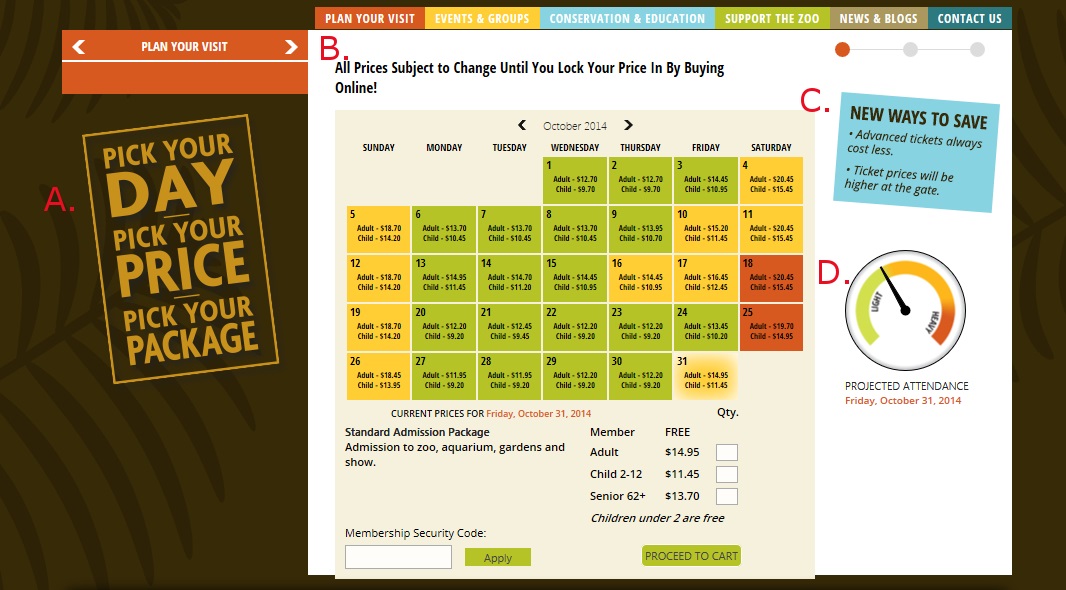At a recent trade show, I took some time away from the show floor to attend a seminar on pricing strategy. I was hoping to hear about new data-driven techniques that could move the industry forward. So I was disappointed when the opening speaker led with, “Sometimes we get mired in the science of pricing and lose sight of the art of pricing.”
The presentations, and the responses to audience questions that followed, made it apparent that there remain many misconceptions about dynamic pricing. Four dynamic pricing myths I heard that day are addressed below:
- MYTH: With so many different prices, your guests will have to do too much work to find the value in your pricing.
The presenters stressed the need for pricing to be communicated clearly to the consumer. And I agree, but dynamic pricing doesn’t change that! Here’s how one attraction communicated effectively to their guests about dynamic pricing:
- “Pick Your Day, Pick Your Price, Pick Your Package” – appears on every page of website to drive home the message that prices differ by day, and that the consumer has choices
- “All Prices Subject to Change Until You Lock Your Price In By Buying Online” – appears on ticketing page to let guests know that dynamic pricing is in effect
- “New Ways to Save” – highlights the value of purchasing tickets early, as dynamic pricing is, in this case, constrained only to raise prices and never lower them
- “Projected Attendance” – dynamic pricing algorithm uses actual purchases and historical trends to forecast attendance, helping the consumer choose a less crowded day if desired
- MYTH: You don’t want your guests to be angry when they find out someone got a ticket at a better price than they did!
This is the most common fear about dynamic pricing; Digonex hears it from prospective customers all the time. However, what we hear from those who have already implemented dynamic pricing is that guests almost never complain about the cost of their tickets relative to someone else’s.In reality, even statically-priced attractions already have guests in their facility at any given time who have paid different amounts due to discounting, group pricing, age-based pricing, or preference given to online vs. at-the-door ticketing. Guests are not likely to focus on the difference between their price and the price someone else paid, unless they feel their own price wasn’t a good value. Dynamically-priced attractions need to continue to focus on providing all guests with a valued experience.
- MYTH: Your brand will be damaged by the perception that you are price gouging.
First, dynamic pricing isn’t only about raising prices. Dynamic pricing IS about aligning your prices with the market demand for your attraction day-by-day (or even hour-by-hour). We often find there are days on which attractions are over-priced, and that the optimal decision is to lower the price on those days thereby enhancing accessibility, attendance and revenues all at the same time.
Second, at Digonex, our algorithms are governed by constraints set by our customers. Dynamic pricing, as we practice it, will never automatically push prices above maximum values that you choose based on your understanding of your guests and what they value. In this way, dynamic pricing helps you realize the revenue potential of your products, but without guests feeling they’ve been taken unfair advantage of. We have found that as long as the new pricing model is transparent and fair, visitors will adapt quickly.
- MYTH: Dynamic pricing only works for those attractions that have capacity constraints or crowding issues.
It’s true that attractions with scarce capacity often stand to benefit the most, financially, from dynamic pricing, which takes advantage of the market’s willingness to pay a premium for scarce resources. And where crowding is concerned, price differences can be used to move consumers from crowded to less-crowded days.
However, all attractions can benefit from dynamic pricing, marrying the established art of pricing, and its reliance on insights and tradition, with the modern science of pricing—configurable algorithms that respond automatically to changes in demand to ensure that the full value of your attraction is being realized at all times.
